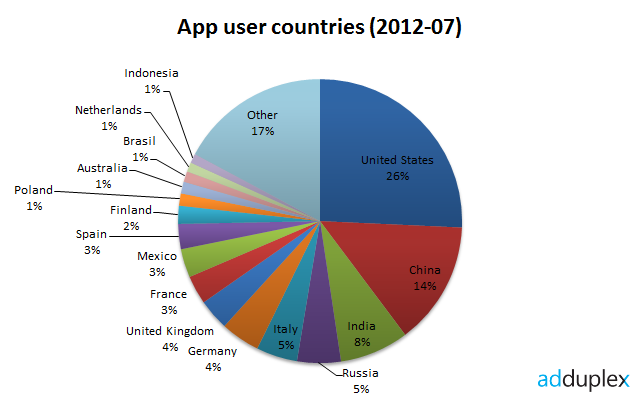App Statistics By Country
This year the iTunes App Store, the first mobile app store launched that set off mobile app development as a business, turns 9. For many indie developers, mid and big size companies it’s been a bumpy road with many ups and downs. There-is-an-app-for-that moment has long gone, the focus from app novelty has shifted to innovation and long-term profitability. The app business is matured and has become part and parcel of the world economy.

From an app store statistics to mobile app statistics, starting with the most popular apps of today. It comes as no surprise that this year Facebook app demonstrates the highest level of penetration among 18+ years old and older with a whopping 81%, with YouTube comes second with 71% and Facebook Messenger third with 68%. Check out our infographic on Mobile Apps Usage for more Statistics And Trends. Did you know that mobile apps now account for more than half (52%).
Over the years, several monetization models emerged and lead to establishing numerous mobile advertising networks, affiliate networks as off-app-store channels for app developers to generate apps revenue. Exclusive Bonus: Let’s look the numbers for how much revenue was generated by the app economy for the last several years and a forecast for a few years in the future. Key App Revenue Statistics: • Global mobile app revenue in 2016 – $88 billion • Global mobile app revenue forecast for 2020 – $189 billion • Global Paid-for mobile app revenues in 2017 – $29 billion • Worldwide In-app purchase revenues in 2017 – $37 billion • US mobile app advertising revenues in 2017 – $33 billion • Top Grossing iOS app in 2017 – Pokemon GO (over $2 billion) First of all, let’s look at the global mobile apps revenue data compiled by App Annie app market data company. In 2015 the total revenue generated across all mobile operating systems was about $70 billion, in 2016 this number reached $88 billion. By 2020 the combined mobile app revenue will reach a staggering $189 billion.
Global mobile apps revenue 2015, 2016 and 2020 in billion US Dollars Source: There are three well-established app monetization models for app developers to choose from – advertising, in-app purchases and Paid-for. For the first several years since major app stores were launched, the bulk of app developers revenue was generated with Paid-for model but than in 2009 and everything changed.
Adobe Cs5 Master Collection Serial Activation Blocker Windows. Gradually, year-over-year in-app purchases began to take over other monetization models and by 2017 way over 50% a mobile app revenue is generated via in-app purchases. Share of global mobile app revenues from 2011 to 2017, by channel Source: Now let’s analyze the three major app revenue generation channels, starting with Paid-for one.
The graph below presents aggregated data from Statista that provides data for Paid-for mobile app revenue from 2011, two years after in-app purchase was introduced, till 2017. During this period the revenue went up from $7 billion in 2011 to $29 billion in 2017. Starting 2015, there is a clear slow down in its growth, which can be attributed to the mobile app ecosystem maturity, mobile app users as they used to and stick to using only a. Global Paid-for mobile app revenues from 2011 to 2017, in million U.S.
Dollars Source: Because by 2011 in-purchase app monetization was only 2 years old, it managed to generate only $712 million, by 2012 it more than doubled and reached over $2 billion and in 2017 the total in-app purchase revenue worldwide reached about $37 billion. By comparing global app revenue generated with Paid-for and in-app purchase models in 2017, we see the latter bitting the former by about $8 billion. Global in-app purchase revenues from 2011 to 2017, in million U.S.
Yamaha Rx V661 Owners Manual more. Dollars Source: In a pursue to increase an app revenue, app developers turn to placing ads inside their apps. There are four major types of mobile ads – Display, Search, Social and Video. The data from BusinessInsider provides a percentage split for these four starting from 2013 to this year and a projected revenue for 2018.
Pdf For Benhawan Poomsan Becker Thai Language Pdf. Throughout this period Search has been the major channel to generate mobile ad revenue, contributing from $3.7 billion out of 7 in 2013 to $17.7 billion out of $32.9 billion in 2017. US mobile app advertising revenues from 2013 to 2018, in billion U.S. Dollars Source: Between two biggest mobile platforms – Apple’s iOS and Google’s Android, the former has always been more lucrative for app developers and the latter advantage has been its broader reach. Apple leverages its several hundred million iTunes users base that demonstrate high level of trust and satisfaction with Apple’s hardware and software. Google’s Android is available on dozens of smartphones and hence the Android’s broad reach. In 2016 iOS generated twice as much as Android did, $34 billion against $17 and more than 3 times of revenue generated on third-party Android stores that brought only $10 billions. In 2017 the overall proportion remains the same – Apple’s iOS generated $40 billion, Google Play $21 billion and third-party stores $20 billion.